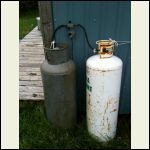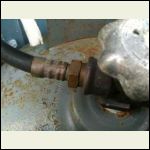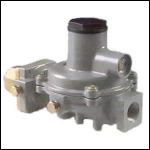|
| Author |
Message |
spillenger
Member
|
# Posted: 14 Jul 2011 08:35am
Reply
I have run a small Dometic propane fridge off a 20-pound cylinder for a few years now in my cabin. Now I'm installing a small range and am going to switch over to 100-pounders to run both the range and the fridge. The local propane company can't get to my cabin -- it's too remote -- so they suggested I get a 100-pounder and install it myself (with the help of more knowledgeable plumber-type friends of mine, of course). I'm aware of the potential dangers of installing propane oneself, but I'm not going to turn anything on until I get the approval of someone here I know knows what he's doing.
My questions are very basic ones, which are nonetheless a little difficult to find on the web:
1. Are typical 20-pound and 100-pound cylinder flared female outlets a standardized size in the US and Canada? If so, what size are they and are they both the same?
2. My fridge has a 3/4" SAE male flare connection that goes to the regulator assembly. Is this a standard size for propane/NG appliances? I am about to buy a Kenmore range from Sears and there doesn't seem to be any way to find out what its intake fitting size is.
3. I have read that it's important if you have an indoor appliance (such as this Kenmore NG range that comes with a propane conversion kit) to use a twin-stage regulator, not just a single-stage one. Is this correct?
4. If I have two appliances (fridge and range) being fueled by a single cylinder, do I need two regulators? Or can one buy a "splitter" off one regulator? If I need two regulators, why? And how does one set that up?
5. What are the standard sizes of the flared fittings used on either end of the regulator hose going to a propane appliance?
6. Since my range will be at a distance from the propane cylinder (maybe 20 feet), would it be best to use 1/2" copper pipe to connect the two? And if so, is there a tool that will allow you to connect the proper flared fittings at either end?
7. I'm not yet experienced enough to know the size of a fitting just by looking at it. I wouldn't know a 3/8" from a 1/2". Can one measure it with a simple ruler? And is the measurement of the inside of the female and the outside of the male? I assume it is diameter we're talking about.
Please note: Based on any advice I get here, I am NOT going to run out and connect everything up myself. I'm not that dumb. I am going to rely completely on the advice of experienced (and still alive!) cabin dwellers here. This is purely for informational purposes, so I have a general handle on the subject when I talk to these guys.
Many thanks,
Paul
|
|
Kithera
Member
|
# Posted: 14 Jul 2011 03:58pm
Reply
It's been a long time since I've worked with gas, and even that was only a waster course in HS.
That said, at least for number 6, there is a flare tool, available at any good home store. You put your nut on your pipe, attach the flare tool to the end, tighten it down to flare the pipe, and then put the flared part on your attachment and tighten the nut. It's pretty easy.
|
|
Anonymous
|
# Posted: 14 Jul 2011 06:24pm
Reply
I can't offer you help on the hook up. But I think you should go on Ebay and get a propane gas detector. There are a few on there. I don't remember the brand name it is about $165.00. It takes a 9 volt battery.
|
|
Rob_O
|
# Posted: 14 Jul 2011 08:28pm
Reply
The #6 line Kithera speaks of is standard 3/8" soft copper line. It is commonly used to run from the tank to a regulator at the house.
From there, you need to size the line according to the BTU requirements of your appliances. I would expect your new range to have a 1/2" FIP fitting
There's good info about the capacity of various line sizes Here and good info about how much your available capacity drops with the temperature Here.
|
|
MtnDon
Member
|
# Posted: 14 Jul 2011 10:52pm
Reply
1. All the portable cylinders use the same fitting size. Note that 100#'ers weigh about 175# when full (or something close to that). Buy a hand truck for moving them.
2. There is no real standard other than a 3/8" flare fitting is the same from any mfg. And so on for all the sizes. Adapters are used where necessary.
3. Always use a two stage regulator unless you are simply feeding a single simple appliance like a grill. Regulators are sized to capacity too. It should have a capacity greater than the max BTU draw of all appliances totalled up. Plus some extra for whatever it is gets added in a year or two.
4. When using portable cylinders it is very convenient to use a two stage automatic changeover regulator. That allows 2 cylinders to be hooked up using flexible rubber lines. When one runs out the regulator switches to the other tank. They have indicators to show when that has happened. Never a hiccup with a system like that.
5. Depends on the regulator
6. Rob_O covered that well. Also note: do not buy a cheap flare tool. Buy a good, more expensive one and you will have better flares and save the time/hassel of having to buy the good one after you have troubles with the cheap tool. Ridgid makes a good one.
7. One of the easiest ways to get a handle on flare sizing would be to buy a few different sizes and mark them. Tubing sizes can get confusing as different folks sometimes talk ID and OD and get things all balled up.
Thanks Rob_O for the link to my adventures in propane tanks and cold weather.
|
|
spillenger
Member
|
# Posted: 15 Jul 2011 07:00am
Reply
Thanks, everyone, for all your help and great advice. The technician from the propane company said (after he told me he couldn't deliver propane to me and I was on my own) I needed a setup that would handle a 55,000-60,000 BTU load -- that would be just a small range and a small fridge.
My cabin is in Cape Breton, Nova Scotia, and the closest "city" (large town) is Sydney. They have a Sears and a Home Depot and a Canadian Tire. But I suspect that it might be best to go to an RV supply place for some of these fittings -- it's really the fittings that are driving me crazy. In the last few years here, it seems the government has cracked down on suppliers of fittings, couplers and regulators to not sell these things. My local hardware guy went a little pale when I asked. "No, no, no, we can't do that anymore," he said.
Anyway, thanks again. Your advice helped a lot.
best,
Paul
|
|
spillenger
Member
|
# Posted: 17 Jul 2011 08:27am
Reply
Propane Setup Update (see attached photos):
I have made some progress on this project, thanks to suggestions from people on this forum and some research of my own. This is what I've come up with.
100-pound propane tank with a standard ½" female flared output ...
... to which I connect a coupling (adapter) that is ½" male on one side and compatible with standard propane hose flared connector on the other. (in other words, I simply want to connect one end of the hose to the propane tank.)
The other end of the propane hose goes to the Fisher R232 2-stage regulator, via a coupling/adapter.
The regulator inlet looks to be 1/8" or ¼" female flared? (I can't figure out what it is – nothing I have seems to fit it, and the manual I found online doesn't seem to say.) So the coupling needs to be a male matching that and then go to the standard propane hose coming from the tank (whatever that is).
The regulator outlet looks to be about ¾". The coupling coming out of that needs to be a "T"-connection, so I can go from the regulator to both the fridge (Dometic) and the stove (Kenmore). May need an adapter to get to the T from the regulator.
Out of the two outlets of the T comes the length of 3/8" soft copper line (#6 line), which must be flared with a flaring tool on both ends. One length goes to stove, the other to the fridge. The fridge intake is a male 3/8" flared fitting. The stove is probably the same or ½".
I spent an entire day in the closest city, Sydney, N.S., being shuttled from one parts supplier to the next, none of which in the end was able to help me, aside from selling me the Fisher R232 regulator, which I guess is a step forward. Life would be good if these fittings just had a little notation etched into them saying "I am 3/8"" or "I am ½"." But they don't. If I knew exactly what parts to order, I'd mail-order them from someplace rather than waste days and brain cells going to Sydney.
Thanks again for the clarification and advice I've already gotten. If anyone has anything to add based on this new information, I'd be very grateful.
Paul
2_100lb_propane_tank.jpg
| 
tank_fitting.jpg
| 
fisher_r232bbf_regu.jpg
|  |
|
|
turkeyhunter
Member
|
# Posted: 17 Jul 2011 09:00am
Reply
glad you got it worked out.............now you are cooking with G A S!!!!
|
|
|
millstream
|
# Posted: 21 Jul 2011 10:58pm
Reply
Well we just got done with repiping our cabin last week thanks to the people that decided they needed our copper more than we did over the winter. Your set up looks very similar to ours, and like you we had a hard time locating the correct fittings. We had to take all our "manifold & regulator fittings and pieces to the closest ace hardware to our camp (45 min.) Back where we live, 6 hrs away they don't even stock 1/4 flare tees. Off our regulator it's a 3/8pipe fitting. (I adapted to 1/2 black pipe manifold there)
My fridge (old) had 1/2" flare fitting, stove (older yet) had 3/4 inch pipe.
WHile I can't give you specifics from the pics, keep in mind there are basically 2 types of threads you will encounter (ignore all compression fittings as they aren't for gas). Flare and Pipe. Flare threads are a little steeper and a hair smaller in diameter than pipe, plus they have the distinctive cone at the end of the male fittings. All diameters will be based upon ID, not OD, of the pipe. With all flare fitting do not use pipe wrap, as the flare at the end of it is your "gasket". With black pipe use yellow gas tape. @-3 wraps at most. With the black pipe the taper is cut into the threads and is harder to visually see.
Hope this helps a little.
|
|
Anonymous
|
# Posted: 21 Jul 2011 11:26pm
Reply
If you have homeowners insurance it will be void because your propane is not up to code.
|
|
|

